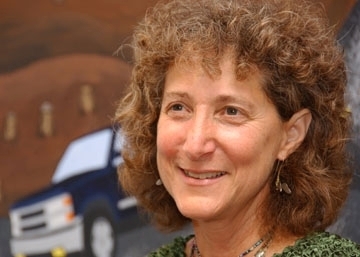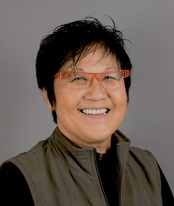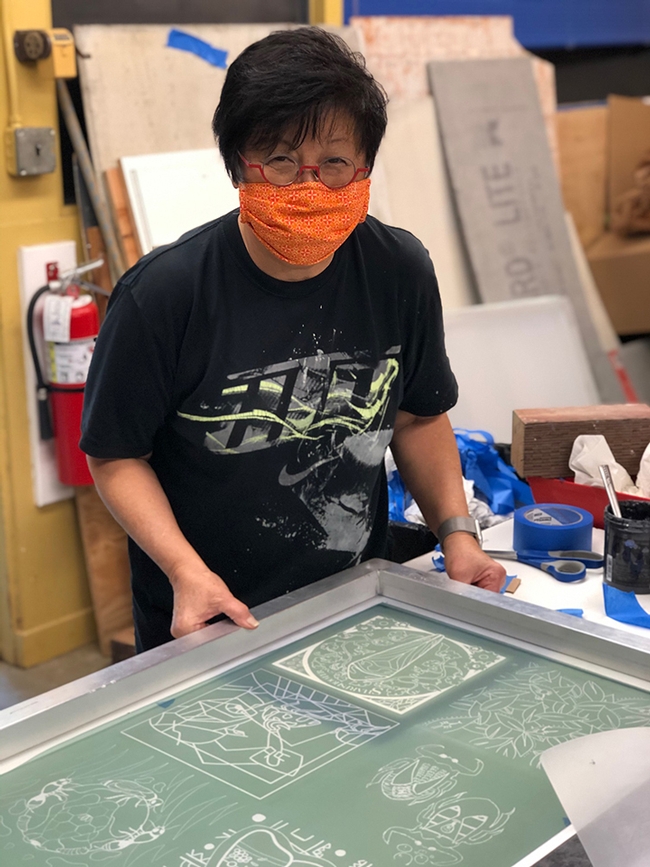
UC Davis faculty members Diane Ullman and Gale Okumura challenged their students to do just that in their remote-instructed class “The Power of Visual Language through Symbolism and Expression in Clay” and the result is an amazing mural, "When Words Are Not Enough."
The newly installed nine-tile mural, featuring flora and fauna designs, graces the wall just outside Room 126 of the Environmental Horticulture Building, 200 Arboretum Drive. Measuring 36 x 34-inches, it's the collaborative work of students Leslie Briceno-Marquez, Jason Hu, Analiese Ignacio, Heewon Shin, Emma Storm, Anushka Vispute and Mia Xiong, and their instructors.
Ullman, an artist and entomologist, is a professor and former chair of the UC Davis Department of Entomology and Nematology. Okumura is an artist, designer and lecturer with the UC Davis Department of Design.
The mural includes a honey bee, created by Storm, an anise swallowtail butterfly by Briceno-Marquez, and an octopus by Anushka Vispute.
Students learned the history of the use of symbols and signs in visual language from ancient to contemporary times, and gained an introduction to basic design principles, including the golden ratio, rule of thirds, and the use of lines, shapes, composition and perspective, as well as color theory and Gestalt Principles. They then applied them to their designs

The instructors billed the course as “how to use symbolic representation in design and visual narrative to enhance expression and understanding of ideas and concepts.” Each student designed a symbol and then integrated it with their classmates' symbols in an online collaborative process. The work was then printed on tiles using a screen-printing method.
“The ability of the students to absorb such diverse information and transform their learning into meaningful designs was impressive,” Ullman said. “Each of the designs is very personal, but also expressive of a world view based on hope. Transforming their work into the cohesive mural we had all imagined together was exciting and transformative for the students and for us as teachers.”
Remote instruction proved to be challenging at times. “This class was meant to be highly participatory and hands on, so leading discussions in a remote environment and not being able to have students in our classroom, also called the Labudio (Lab plus Studio) was really difficult,” Ullman said. “We overcame this obstacle by sending them the materials they needed to draw their designs and then we used their digitized designs to print the design on ceramic tiles that were sent to them for completion, along with the glazes and brushes they needed. They then sent them back to us and we fired them.”
“This meant that all the steps of screen printing they would have learned and done themselves in the Labudio—printing film positives of their designs, coating silk screens with special emulsion, burning the screens with their designs, printing their designs with underglaze on ceramic tiles, had to be done by us. In addition, we had to prepare and address the packages. Even though the class was relatively small, this was labor intensive.”
Several artists from the UC Davis and local community rushed to their aid: Sarah Rizzo, Teresa Slack, Val Jones and Heather Mechling Eckels. Some are associated with the UC Davis Art-Science Fusion Program, co-founded by Ullman and artist Donna Billick of Davis, now a retired co-director of the program.
“It was a challenge because we maintained all social distancing mandates and could not be there all at the same time,” Ullman pointed out. “Everyone wore masks when they came to help, and we disinfected the space with bleach every time we worked there. They all came at different times to help—entirely out of the goodness of their hearts. We are so grateful for their helping hands.”
The instructors credited Bay Area artist Jos Sances with “sharing his printing techniques and loaning us emulsion when we couldn't buy it due to the pandemic. Donna Billick helped install the mural and taught us how to do it for the next mural installation. We are grateful for the life-long learning opportunity this work has been for us and our opportunity to meet and learn from these great artists.”
The mural has drawn dozens of accolades on Ullman's Facebook page:
- “It's just gorgeous!”
- "That octopus is amazing. Well, in fact each square has such awesome treasures.”
- “Love this!”
- “So beautiful!
- “Wow! This is beautiful—and even more impressive given the challenges with online learning”
- “This is so cool”
The instructors are teaching the same class this quarter and look forward to more creativity.
The Environmental Horticulture Building mural is one of 36 projects either installed or exhibited by students of Ullman—who teaches Entomology 001 and first-year seminars--and her collaborators, including Billick and Okumura.
Attached Images:

This is the mural newly installed in the hallway of the the UC Davis Environmental Horticulture Building. The tiles are the work of top (from left) Heewon Shin, Diane Ullman, and Mai Xiong; center (from left) Jason Hu, Emma Stone, and Analiese Ignacio, and bottom (from left) Anushka Vispute, Gale Okumura, and Leslie Briceno-Marquez.

Designer-lecturer Gale Okumura of the UC Davis Department of Design engaged in printing